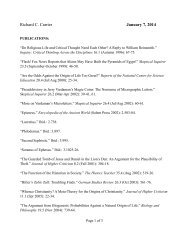Cultural History of the Lunar and Solar Eclipse in ... - Richard Carrier
Cultural History of the Lunar and Solar Eclipse in ... - Richard Carrier
Cultural History of the Lunar and Solar Eclipse in ... - Richard Carrier
You also want an ePaper? Increase the reach of your titles
YUMPU automatically turns print PDFs into web optimized ePapers that Google loves.
elder Pl<strong>in</strong>y, whose explanation is based on basic geometry, correctly assum<strong>in</strong>g <strong>the</strong><br />
excessive size <strong>of</strong> <strong>the</strong> sun, but does not recognize <strong>the</strong> effects <strong>of</strong> refraction. 64 As a result<br />
<strong>of</strong> this bend<strong>in</strong>g <strong>of</strong> light, a moon <strong>in</strong> eclipse can change colors, s<strong>in</strong>ce, as we see <strong>in</strong> a<br />
prism, light bends differently accord<strong>in</strong>g to its frequency <strong>in</strong> <strong>the</strong> color spectrum, <strong>the</strong> red<br />
bend<strong>in</strong>g <strong>the</strong> most, blue <strong>the</strong> least. Thus, <strong>the</strong> most common color <strong>of</strong> <strong>the</strong> moon <strong>in</strong> full<br />
eclipse is red, which has <strong>the</strong> longest wavelength <strong>of</strong> visible light <strong>and</strong> thus bends <strong>the</strong><br />
far<strong>the</strong>st, <strong>and</strong> many ancient records report <strong>the</strong> moon turn<strong>in</strong>g red. 65 These color changes<br />
were observed, noted, <strong>and</strong> understood to correspond with <strong>the</strong> depth <strong>of</strong> <strong>the</strong> moon’s<br />
passage <strong>in</strong>to <strong>the</strong> Earth’s shadow, but no one, <strong>of</strong> course, figured out <strong>the</strong> real reason for<br />
<strong>the</strong> color changes. 66 On very rare occasions, <strong>the</strong> moon can fall so far <strong>in</strong>to Earth’s<br />
shadow that no refracted light reaches it at all. These are calleed ‘dark’ lunar eclipses,<br />
<strong>and</strong> <strong>the</strong>y are black <strong>in</strong>deed, though not necessarily ‘<strong>in</strong>visible’. Meteorological factors can<br />
also affect both <strong>the</strong> color <strong>and</strong> visibility <strong>of</strong> <strong>the</strong> moon, such that many ‘dark’ eclipses<br />
identified even <strong>in</strong> <strong>the</strong> past two centuries are actually <strong>the</strong> result <strong>of</strong> recent volcanic activity<br />
affect<strong>in</strong>g <strong>the</strong> transmission <strong>of</strong> light through <strong>the</strong> atmosphere. 67<br />
<strong>Lunar</strong> eclipses differ from solar <strong>in</strong> two important respects: because <strong>the</strong> Earth is<br />
so much larger than <strong>the</strong> moon, <strong>and</strong> <strong>the</strong> sun so distant, a lunar eclipse is visible to<br />
everyone <strong>in</strong> that part <strong>of</strong> <strong>the</strong> world experienc<strong>in</strong>g nightfall -- though <strong>the</strong> time at which it<br />
beg<strong>in</strong>s <strong>and</strong> ends will vary from east to west, as was well known to <strong>the</strong> poet-astrologer<br />
Marcus Manilius <strong>and</strong> o<strong>the</strong>rs. 68 And s<strong>in</strong>ce <strong>the</strong> <strong>in</strong>cl<strong>in</strong>ation <strong>of</strong> <strong>the</strong> lunar orbit is virtually<br />
irrelevant to whe<strong>the</strong>r it falls under <strong>the</strong> Earth’s shadow, lunar eclipses are far more<br />
common, occurr<strong>in</strong>g on average two to three times every year, but not all <strong>of</strong> <strong>the</strong>se will<br />
occur on <strong>the</strong> same side <strong>of</strong> <strong>the</strong> Earth, nor will all be visible even <strong>the</strong>n, s<strong>in</strong>ce clouds <strong>of</strong>ten<br />
hide <strong>the</strong> event. The frequency <strong>and</strong> pervasiveness <strong>of</strong> lunar eclipses makes predict<strong>in</strong>g<br />
<strong>the</strong>m remarkably easy. In fact, it is not even necessary to underst<strong>and</strong> <strong>the</strong> astronomical<br />
details. A careful observer will discover that lunar eclipses occur <strong>in</strong> regular cycles with<br />
<strong>in</strong>terweav<strong>in</strong>g periods <strong>of</strong> five <strong>and</strong> six months. 69 It is possible to draw up tables which will<br />
accurately predict lunar eclipses hundreds <strong>of</strong> years <strong>in</strong> advance solely by crunch<strong>in</strong>g<br />
numbers. <strong>Solar</strong> eclipses also have cycles, though much greater <strong>in</strong> magnitude. There<br />
are 11 year <strong>and</strong> 1,841-year-<strong>and</strong>-1-month cycles, among o<strong>the</strong>rs. Interest<strong>in</strong>gly enough,<br />
solar eclipses which had occurred <strong>in</strong> <strong>the</strong> 2nd century Roman Empire were repeated <strong>in</strong><br />
64 Natural <strong>History</strong>, 2.7.(47-8), 2.8.(51-2); cf. also Dio Cassius 60.26.5.<br />
65 E.g. Qu<strong>in</strong>tus Curtius Rufus, <strong>History</strong> <strong>of</strong> Alex<strong>and</strong>er, 4.10.2; Dio Cassius, who also mentions its shift<strong>in</strong>g through<br />
o<strong>the</strong>r colors, 64.11.1, etc., as does Plutarch, The Face on <strong>the</strong> Moon, 934C-D. When we deal with superstition, we<br />
will see <strong>the</strong> red moon appear<strong>in</strong>g aga<strong>in</strong>.<br />
66 Cf. Seneca, Natural Questions, 7.27.1; Plutarch, Aemilius Paulus, 17.7; Nicias, 23.2; <strong>and</strong> The Face on <strong>the</strong> Moon,<br />
19 (934C-E) also comes close to <strong>the</strong> truth, though only vaguely. In <strong>the</strong> latter source, Plutarch notes that colors vary<br />
accord<strong>in</strong>g to <strong>the</strong> time <strong>of</strong> night <strong>the</strong> eclipse occurs, which happens to correspond to <strong>the</strong> fact that this affects <strong>the</strong> depth<br />
<strong>of</strong> shadow.<br />
67 Cf. Bicknell; Sto<strong>the</strong>rs.<br />
68 Astronomica, 1.221-227; cf. also Plutarch, The Face on <strong>the</strong> Moon, 19 (932F); Pl<strong>in</strong>y, Natural <strong>History</strong>, 2.72 (180).<br />
69 Schove, p. ix; Thurston, p. 17-19; Ptolemy, Almagest, 6.7; Pl<strong>in</strong>y <strong>the</strong> elder, Natural <strong>History</strong>, 2.10; Plutarch, The<br />
Face on <strong>the</strong> Moon, 933D.








